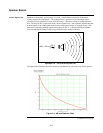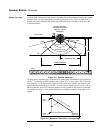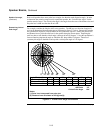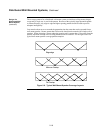
2-16
The preceding sections apply primarily to ceiling mounted speakers, generally referred to as
“Distributed Overhead Systems.” Another useful mounting strategy is the “Distributed Wall
Mount System.” Under this configuration, the speakers are placed on walls or columns, and are
aimed into the room. Advantages and disadvantages of distributed wall mount systems are
described in the following sections.
• For narrow areas such as hallways, fewer speakers and less amplifier power may be needed to
cover the same size area. This is because all of the speaker’s sound contributes to useable
audibility.
• Mounting can be on more than one wall. This further improves the distribution of direct
sound to the listener.
• Wall mounted speakers put sound directly into the listener area. This can reduce the
excitation of the reverberant field.
• Combination speaker strobe units permit voice and visual notification in a single appliance.
• The sound field from wall mount speakers is more likely to encounter obstructions from
furnishings such as cubicle walls in office environments or movable partitions in conference
rooms. If the furnishings in a room are likely to change, a distributed overhead system or a
combination wall mount and overhead design should be considered. This minimizes the
variation of audibility and intelligibility.
• In rooms with low, hard ceilings the sound emitting from the top hemisphere of the coverage
pattern is reflected off the ceiling and down to the listener. This can increase the reverberant
field sound level and result in delayed arrival of sound. These factors both contribute to a
reduction in intelligibility.
Continued on next page
Distributed Wall Mounted Systems
Introduction
Advantages
Disadvantages


















